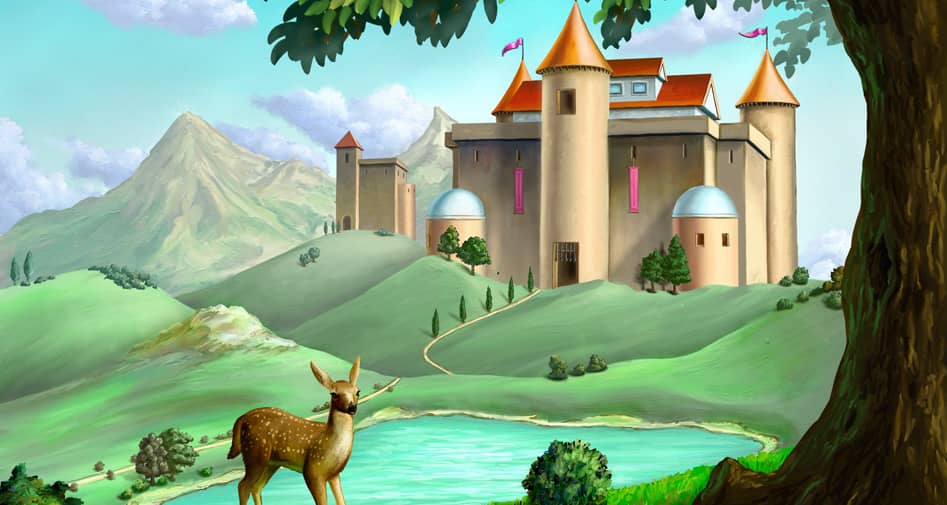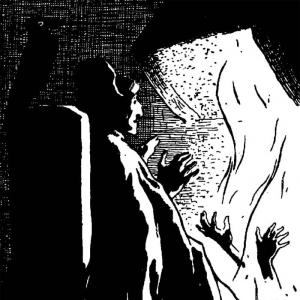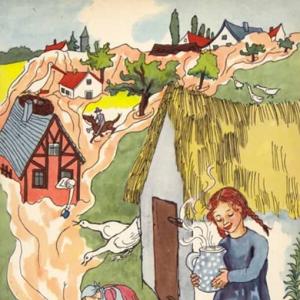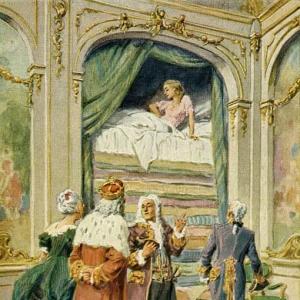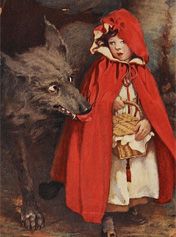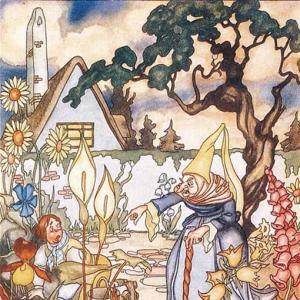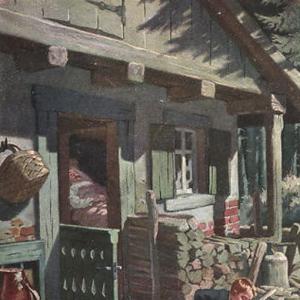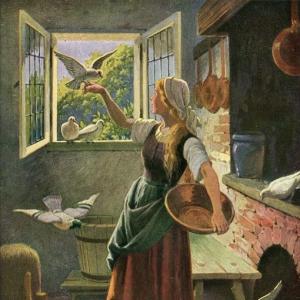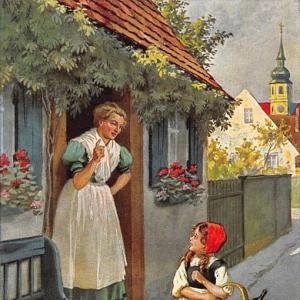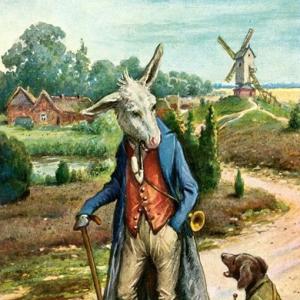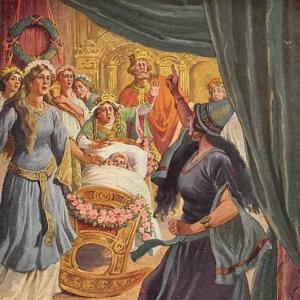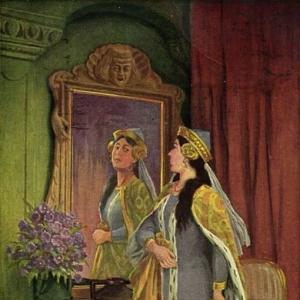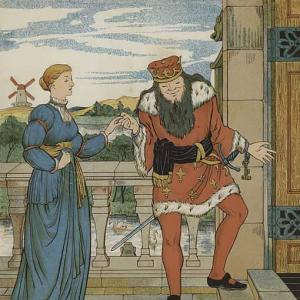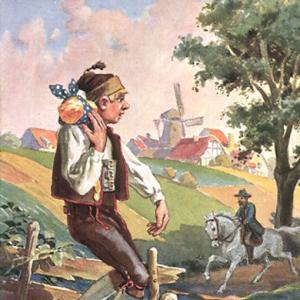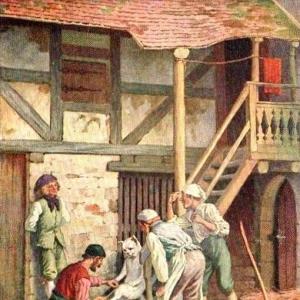Reading time for children: 6 min
There was a large party for children at the house of the merchant; rich people’s children and important people’s children were all there. Their host, the merchant, was a learned man. His father had insisted that he have a college education. You see, his father had been only a cattle dealer, but he had always been honest and thrifty. This business had brought him a fortune, and his son, the merchant, had later managed to increase this fortune. Clever as he was, he also had a kind heart, but there was less talk about his heart than about his money. His house was always full of guests. Some who had „blue blood,“ as it is called, and some who had mind. Some who had both, and some who had neither. But this time it was a children’s party, with children’s prattle; and children say what they mean. Among the guests was a pretty little girl, most absurdly proud that her father was a groom of the bedchamber. The servants had taught her this arrogance, not her parents. They were much too sensible.
„I’m a child of the chamber,“ she said. She might as well have been a child of the cellar, for no one can help his birth. Then she explained to the other children that she had „birth,“ and insisted that anyone who didn’t have „birth“ from the beginning couldn’t in any way get it. It did no good to study or be ever so industrious if you didn’t have „birth.“ And as for people whose names ended with „sen,“ she declared, „They’ll never amount to anything. You must put your arms out at the side and keep them, these ’sen‘ people, at a distance, like this!“ And with this she stretched her delicate little arms with the elbows turned out to show what she meant-and the little arms were very pretty. Sweet child!
But the little daughter of the merchant was very angry, for her father’s name was Madsen, and of course she knew that ended with „sen,“ so she answered, as proudly as she could: „My father can buy a hundred dollars‘ worth of sugar candy and just throw it away; can your father afford to do that?“
„Yes, but my father,“ said the little daughter of a writer, „can put your father and her father and everybody else’s father into a newspaper! My mother says everybody is afraid of him because he owns the paper!“ And then she strutted as though she were a real little princess who knows how to strut!
Meanwhile a poor boy stood right outside the half-open door, peeping through the crack. This youngster was so humble that he wasn’t even allowed into the room. He had been helping the cook by turning the spit, and now he had permission to peep through the door at the beautifully dressed children who were enjoying themselves inside, and that meant a lot to him.
„Wish I were one of them,“ he thought, and then he heard what they said, and that was enough to make him very sad. His parents had not saved a penny. They couldn’t afford to buy a newspaper, much less write for one. Worst of all, his father’s name, and hence his own, ended with „sen.“ He could never amount to anything in this world! That was sad, indeed. But still it seemed to him he had been „born.“ Yes, just like everybody else-it couldn’t possibly be otherwise.
So much for that evening.
Many years had passed, and in that time children grow up. Now there stood in the city a handsome house, full of beautiful treasures, and everybody wanted to see it, even people who lived outside the city came to see it. And which of the children we have told you about owned this house? Yes, that’s very easy for you to guess. No, it’s not so very easy after all! That house belonged to the poor little boy! He had amounted to something, in spite of the „sen“ at the end of his name-Thorvaldsen!
And the three other children-the children of blue blood, money, and intellectual pride? Well, one had nothing to reproach the other with. They were all equal as children, and they turned into charming and pleasant people, for they were really good at heart. What they had thought and said that evening had just been children’s prattle.
 Learn languages. Double-tap on a word.Learn languages in context with Childstories.org and Deepl.com.
Learn languages. Double-tap on a word.Learn languages in context with Childstories.org and Deepl.com.Backgrounds
Interpretations
Adaptions
Summary
Linguistics
„Children’s Prattle“ is a short story written by Danish author Hans Christian Andersen, who is well-known for his fairy tales and children’s stories. Born on April 2, 1805, in Odense, Denmark, Andersen became one of the most famous and influential writers of his time. His fairy tales have been translated into over 100 languages and continue to be loved by children and adults alike.
Andersen’s fairy tales often include moral lessons and memorable characters, ranging from anthropomorphic animals to royalty and commoners. Some of his most famous works include „The Little Mermaid,“ „The Ugly Duckling,“ „The Emperor’s New Clothes,“ and „The Princess and the Pea.“
In „Children’s Prattle,“ Andersen explores themes of social class, personal growth, and the transformative power of time. The story highlights the importance of humility, the potential for success in everyone, and the impact of childhood experiences on personal development. While this particular tale may not be as well-known as some of Andersen’s other works, it still offers valuable lessons and insights into human behavior and societal expectations.
Andersen’s stories often reflect aspects of his own life and experiences, which were marked by struggles with poverty, social class, and a quest for recognition. It is possible that the story of the poor boy in „Children’s Prattle“ is inspired by his own life and journey to become a celebrated author, emphasizing the theme of overcoming adversity and societal limitations to achieve success.
„Children’s Prattle“ offers several interpretations and messages:
The importance of humility and not judging others: The story serves as a reminder that being overly proud or judging others based on superficial factors such as social standing, wealth, or family background is unwise. The children at the party display arrogance and a sense of superiority, which the story eventually challenges by demonstrating that these things do not define a person’s worth or potential.
The potential for growth and success in every individual: Despite the poor boy’s initial belief that he will never amount to anything due to his surname, he eventually becomes a successful and famous sculptor. This highlights the idea that everyone has the potential for growth and success, regardless of their background or circumstances.
The impact of childhood experiences on personal development: The story illustrates the role that childhood experiences and beliefs can have on shaping an individual’s self-image and expectations. The children’s prattle about social standing and surnames affect the poor boy’s perception of himself. However, he ultimately defies these expectations and rises above his circumstances, suggesting that one can overcome negative childhood experiences.
The transformative power of time and personal growth: The story shows that the judgments and beliefs of the children at the party change over time as they grow up and become more mature. The once arrogant and proud children evolve into charming and pleasant adults, emphasizing that personal growth can lead to a more compassionate and understanding perspective.
Overall, „Children’s Prattle“ serves as a reminder of the importance of humility, the potential for success in everyone, the impact of childhood experiences, and the transformative power of time and personal growth.
„Children’s Prattle“ by Hans Christian Andersen has inspired several adaptations in various forms of media. Here are some notable adaptations:
„The Magic World of Hans Christian Andersen“ (1968): This animated film features several of Andersen’s stories, including „Children’s Prattle.“ The film brings the story to life with vibrant colors and whimsical animation.
„The Wonderful World of Disney: The Littlest Outlaw“ (1955): This live-action film is loosely based on „Children’s Prattle.“ The story follows a young boy who runs away from home and befriends a group of outlaws, who create a magical world of their own.
„The Children’s Prattle“ (2008): This short film adaptation, directed by Michael Bergmann, is a faithful retelling of the original story. The film captures the whimsy and wonder of Andersen’s tale, while also emphasizing its themes of community and imagination.
„Fables“ (2002-2015): This comic book series by Bill Willingham features a character named Ambrose, who is based on Andersen’s story. Ambrose is a talking frog who runs a magical toy store and helps the other characters in the series with their problems.
„Once Upon a Time“ (2011-2018): This TV series features several characters from fairy tales, including a version of Pinocchio who is based on Andersen’s story. In the show, Pinocchio is a young boy who becomes a real boy through the power of his imagination and his belief in his own worth.
Overall, „Children’s Prattle“ has inspired a range of adaptations in various forms of media. These adaptations have brought the story to new audiences and showcased its enduring themes of community, imagination, and childhood wonder.
„Children’s Prattle“ by Hans Christian Andersen tells the story of a children’s party held at the house of a wealthy merchant. The attendees include children from rich and influential families, including a little girl who is proud of her father’s position as a groom of the bedchamber. She explains to the other children the importance of „birth“ and looks down on those with the surname ending in „sen.“ The merchant’s daughter becomes angry, as her father’s name is Madsen, and she boasts about her father’s wealth. Another girl, the daughter of a writer, brags about her father’s influence through owning a newspaper.
A poor boy, who had been helping the cook, is not allowed into the room, but he watches the children through a crack in the door. He feels sad and dejected after hearing the children’s conversation, as his own surname ends in „sen“ and his family cannot even afford to buy a newspaper. He believes he will never amount to anything in life.
Years pass, and a beautiful house filled with treasures is built in the city. The owner of this house turns out to be the once poor boy, who despite having a surname ending in „sen,“ has become the famous sculptor Thorvaldsen. As for the other three children, they grow up to be charming and pleasant adults, as they were good at heart. Their earlier beliefs and statements were simply children’s prattle.
The fairy tale „Children’s Prattle“ by Hans Christian Andersen offers rich material for linguistic analysis, including themes of social class, pride, and personal worth.
Let’s examine the language and thematic elements in the text
Characterization and Dialogue: The characters in the tale are defined largely by social status and familial backgrounds. The language used by the children reflects their upbringing and the values instilled in them. The „prattle“ of the children serves as a commentary on societal values. It illustrates how social prejudices are passed down from one generation to another, as seen in the little girl’s pride in her father’s position and her disdain for those with „sen“ names.
Names and Identity: Names are symbolic in this tale, especially those ending in „sen,“ which the children view as indicative of lower social status. This is a reflection of Danish naming conventions, where „sen“ signifies „son of,“ common among the working class in Andersen’s time. The revelation that the successful individual, Thorvaldsen, once bore the stigmatized „sen“ name challenges social prejudices and demonstrates that one’s worth is not determined by birth or name.
Irony and Satire: Andersen uses irony and satire to critique class consciousness. The children’s innocent yet ignorant dialogues expose the superficiality of social hierarchies. The twist ending, where the poor boy triumphs, subverts expectations and suggests that merit and hard work can transcend social barriers.
Themes of Class and Merit: The merchant, a self-made man, embodies the theme of merit over birthright. His success despite humble beginnings parallels the ultimate success of the „sen“ boy. The tale critiques the aristocracy’s sense of superiority and the false belief that social standing is inherently valuable.
Narrative Tone and Style: The narrative voice maintains a gentle, almost whimsical tone, typical of fairy tales, which adds a layer of accessibility and universality to the moral lessons. Andersen’s use of direct speech and child-like perspectives allows readers to engage with complex social themes through simple, relatable scenarios.
Moral and Message: The story’s moral underscores that true worth and capability are not defined by social standing, echoing the democratic ideals of personal responsibility and equality. The transformation of childish „prattle“ into life lessons illustrates the potential for growth and development in understanding deeper truths about human value.
In summary, Andersen’s „Children’s Prattle“ uses linguistic elements and thematic depth to deliver a timeless critique of social class and the inherent value of individuals, regardless of their birth. The fairy tale’s appeal lies in its ability to address profound societal issues through the innocent lens of childhood conversation.
Information for scientific analysis
Fairy tale statistics | Value |
|---|---|
| Translations | DE, EN, ES, FR |
| Readability Index by Björnsson | 29.7 |
| Flesch-Reading-Ease Index | 78.5 |
| Flesch–Kincaid Grade-Level | 6.1 |
| Gunning Fog Index | 7.9 |
| Coleman–Liau Index | 9 |
| SMOG Index | 8.1 |
| Automated Readability Index | 6.1 |
| Character Count | 4.026 |
| Letter Count | 3.104 |
| Sentence Count | 48 |
| Word Count | 738 |
| Average Words per Sentence | 15,38 |
| Words with more than 6 letters | 106 |
| Percentage of long words | 14.4% |
| Number of Syllables | 983 |
| Average Syllables per Word | 1,33 |
| Words with three Syllables | 34 |
| Percentage Words with three Syllables | 4.6% |
